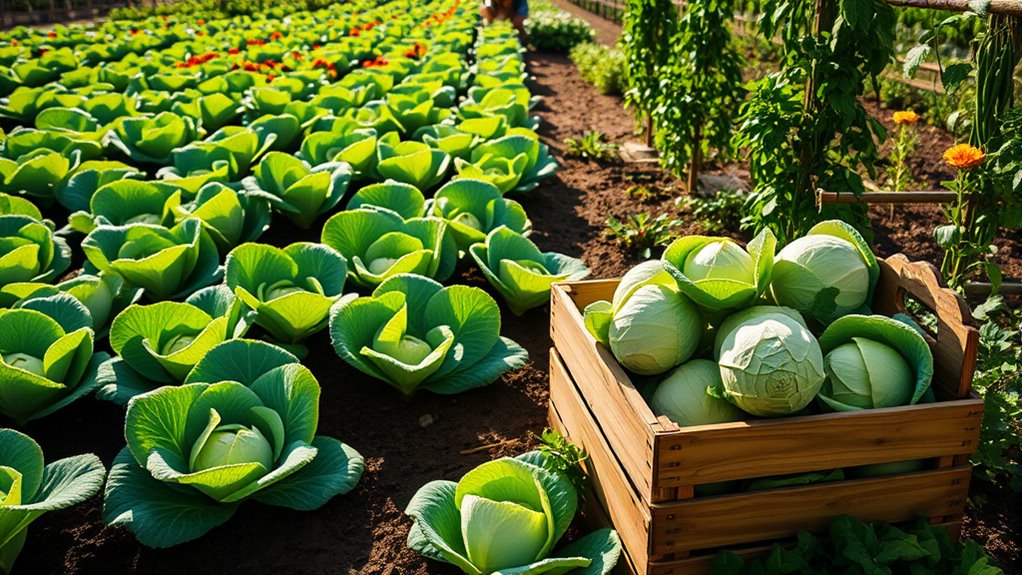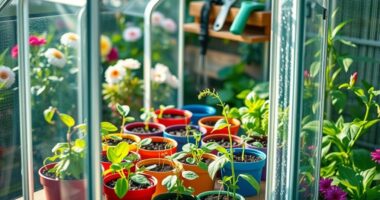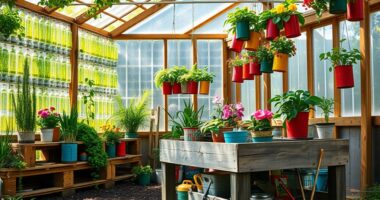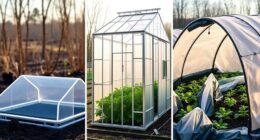To achieve a bountiful cabbage harvest, I’ve found five key techniques that really make a difference. First, select quality heirloom seeds and consider their maturity time. Next, enrich well-drained soil with organic matter. Make sure your cabbage gets at least six hours of sunlight daily, and space plants 12 to 20 inches apart for airflow. Finally, monitor moisture levels to keep the soil consistently moist, especially during germination. Stick around, and you’ll uncover even more tips for successful cabbage cultivation!
Key Takeaways
- Select heirloom, non-GMO seeds suited to your climate for unique flavors and optimal growth.
- Enrich well-drained soil with organic matter and maintain a pH of 6.0 to 7.0 for nutrient availability.
- Provide at least six hours of direct sunlight daily and space seedlings 12 to 20 inches apart for good air circulation.
- Keep soil consistently moist, using drip irrigation or soaker hoses, while avoiding overwatering to prevent root rot.
- Implement organic pest control measures, such as row covers and beneficial insects, to protect crops from infestations.
Napa Michihili Cabbage Seeds for Planting (1000+ Heirloom Seeds)
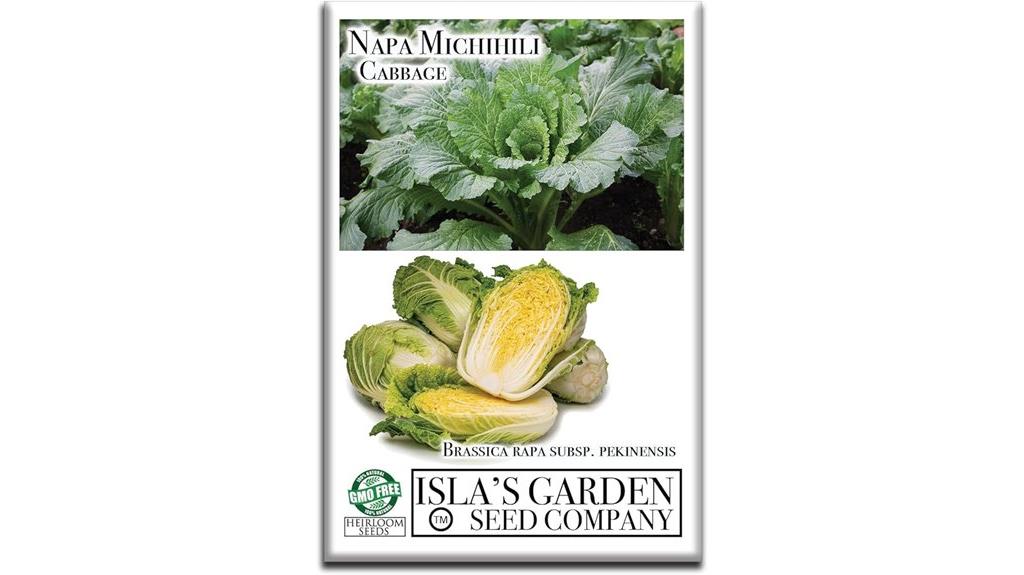
If you’re looking to cultivate a unique and flavorful crop, Napa Michihili Cabbage Seeds are an excellent choice for gardeners of all skill levels. These heirloom, non-GMO seeds produce large, crisp heads that are light green in color. With over 1000 seeds per packet, you’ll have plenty to plant. They thrive in hardiness zones 1-9 and prefer full sun and well-drained soil. I love how they develop a mild, sweet, and peppery flavor, perfect for various dishes. Just remember to keep the soil moist and harvest before the frost for the best results—it’s worth the effort!
Best For: Gardeners of all skill levels looking to grow flavorful and unique crops in a variety of climates.
Pros:
- Heirloom and Non-GMO: These seeds are organic and environmentally friendly, appealing to health-conscious gardeners.
- High Seed Quantity: With over 1000 seeds in each packet, there’s plenty to plant, ensuring a bountiful harvest.
- Mild and Sweet Flavor: The distinctive taste of Napa Michihili cabbage adds a delightful twist to various dishes.
Cons:
- Mixed Germination Rates: Some customers have reported inconsistent germination and growth, which may affect overall yield.
- Incorrect Seed Types: A few reviews mention receiving wrong seed types, leading to potential disappointment in expected crop results.
- Moderate Watering Needs: Requires careful attention to moisture levels, which may be a challenge for some gardeners.
Red Acre Cabbage Seeds for Planting (300 Seeds)
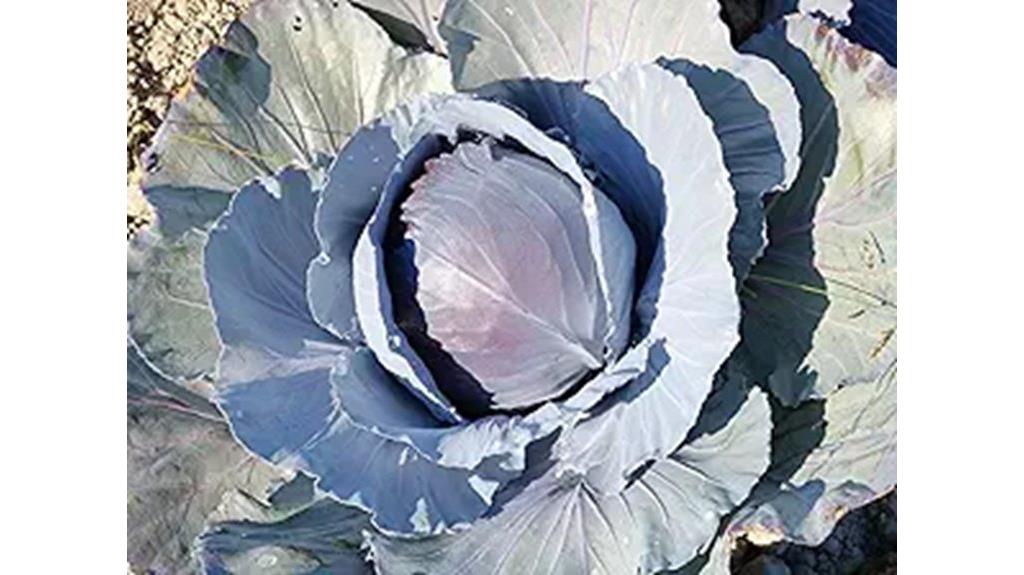
Red Acre Cabbage Seeds are an excellent choice for home gardeners looking to cultivate vibrant, flavorful cabbage. With 300 heirloom, non-GMO seeds in each package from Seeds Of Strength, you’ll have plenty to work with. I love their striking deep red-purple color and crisp texture, perfect for salads, slaws, or stir-fries. To grow them successfully, choose a sunny spot with well-draining soil and plant seeds at 1/4 to 1/2 inch depth. Regular watering and organic mulch help retain moisture. Harvest when heads reach 6-8 inches, and enjoy the bountiful results of your efforts!
Best For: Home gardeners seeking to grow vibrant and flavorful heirloom cabbage in their vegetable gardens.
Pros:
- Heirloom Variety: Non-GMO, untreated seeds allow for organic gardening practices.
- Culinary Versatility: Deep red-purple cabbage is not only visually appealing but also perfect for various dishes like salads and stir-fries.
- High Germination Rate: Premium quality seeds ensure optimal growth and a bountiful harvest.
Cons:
- Requires Specific Conditions: Needs well-draining soil and plenty of sunlight to thrive.
- Thinning Needed: Seedlings must be thinned to ensure proper spacing, which can be labor-intensive.
- Pest Management Required: Organic pest control measures may be necessary to protect crops from pests and diseases.
Savoy Cabbage Seeds for Planting (500+ Heirloom Seeds)
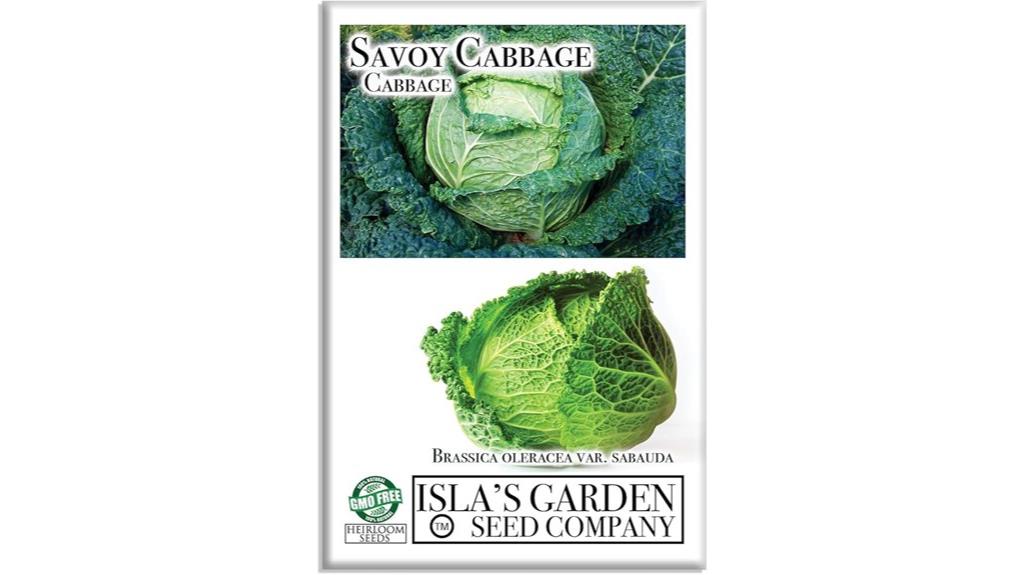
Savoy cabbage seeds, with over 500 heirloom seeds in each packet, are perfect for gardeners looking to cultivate this unique and flavorful vegetable. Originating from the Savoy region in France, these seeds produce large heads with dark-green, bumpy leaves that weigh between 6-8 lbs. I recommend starting the seeds indoors 8-12 weeks before the last frost, planting them in rich soil about 1/2 inch deep. While some gardeners report lower seed counts, proper conditions can lead to great growth. I encourage you to share photos of your harvest; it’s always exciting to see the results of our hard work!
Best For: Gardeners looking to grow flavorful heirloom vegetables in a variety of climates.
Pros:
- High seed count: Each packet contains over 500 heirloom seeds, providing excellent value for gardeners.
- Flavorful produce: Savoy cabbage has a mild and sweet flavor, making it a delicious addition to meals.
- Adaptable growing range: Suitable for USDA Zones 3-12, allowing for cultivation in various climates.
Cons:
- Variable germination rates: Some users report inconsistent seed viability compared to other brands.
- Seed count discrepancies: There are reports of receiving fewer seeds than advertised, around 250 instead of 500.
- Requires specific growing conditions: Optimal growth depends on rich soil and proper lighting, which may not be accessible to all gardeners.
Copenhagen Market Early Cabbage Seeds (300+ Heirloom Seeds)
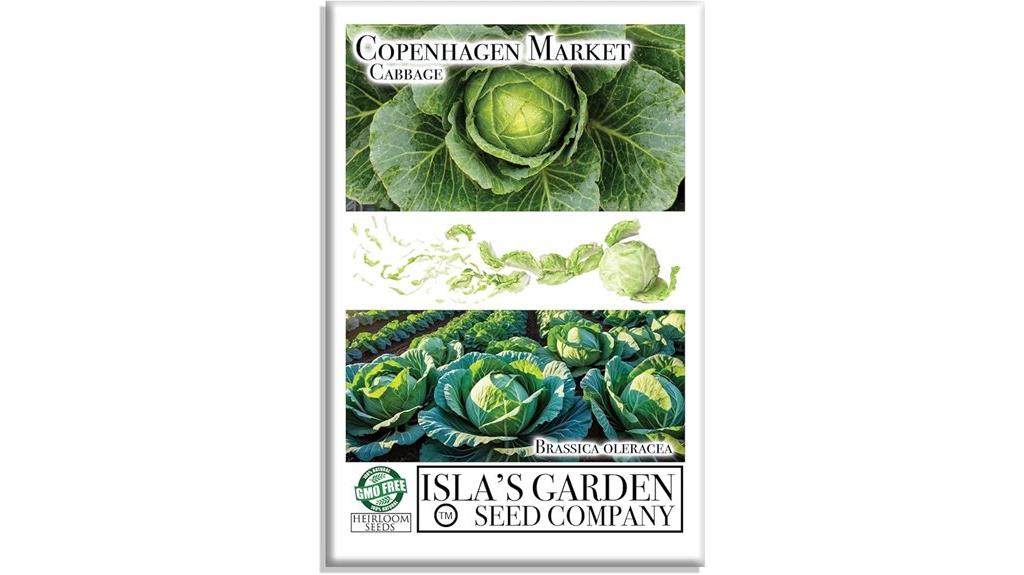
For gardeners looking to cultivate early maturing cabbage, the Copenhagen Market Early Cabbage Seeds are an excellent choice. These heirloom seeds produce beautiful heads that weigh 4-5 lbs and reach about 14 inches tall. I’ve found that they thrive in loamy soil with full sun exposure, and they resist splitting longer than many other varieties. Starting seeds indoors 7-8 weeks before the last frost guarantees a bountiful harvest. Plus, they’re perfect for slaws and stews! With over 300 seeds per packet, you’ll have plenty to share or gift to fellow gardening enthusiasts. Happy planting!
Best For: Gardeners seeking an early maturing cabbage variety that is perfect for fresh slaws, sauerkraut, and stews.
Pros:
- High yield with over 300 heirloom seeds per packet.
- Strong resistance to splitting, allowing for better storage.
- Adapts well to a range of USDA hardiness zones (3-12).
Cons:
- Requires careful monitoring for germination and moisture needs.
- May need to start seeds indoors, requiring additional time and effort.
- Average customer rating of 3.8 out of 5 suggests mixed feedback on performance.
Jigsaw Puzzles 1000 Pieces for Adult Cabbage Cultivation
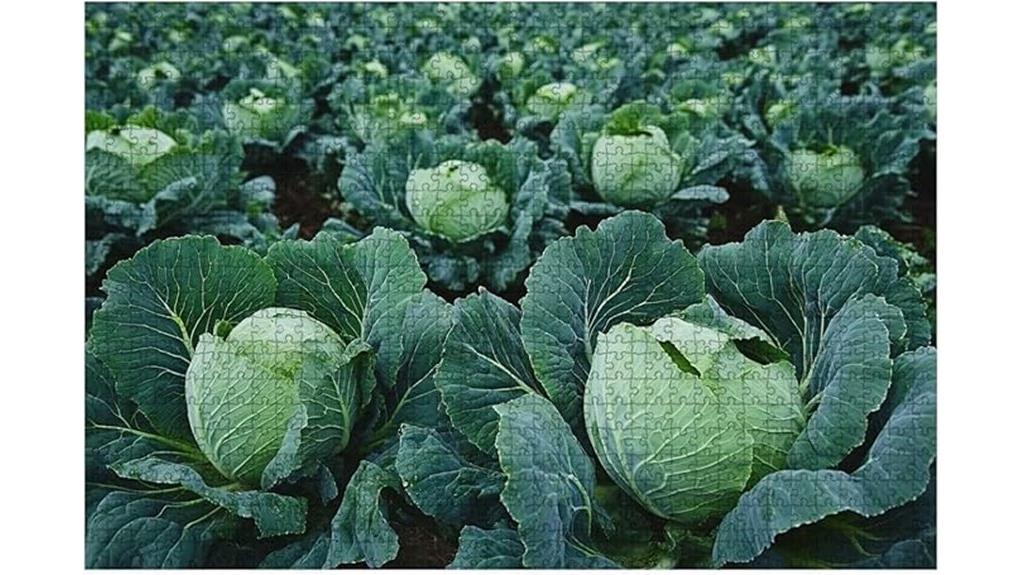
If you’re passionate about gardening and enjoy a good challenge, the Jigsaw Puzzle 1000 Pieces for Adult Cabbage Cultivation is perfect for you. This beautifully crafted puzzle, made from durable alder wood, measures 30 by 20 inches and features unique rounded edges for safety. It’s not just a fun activity; it enhances creativity and problem-solving skills while promoting quiet focus. With its challenging sections, it’s great for teamwork with family and friends. Plus, the vibrant designs make it a lovely decorative piece. Whether you gift it or keep it, it’s a delightful way to unwind and celebrate your love for cabbage cultivation!
Best For: Gardening enthusiasts and puzzle lovers looking for a relaxing and engaging challenge.
Pros:
- Enhances creativity, problem-solving skills, and cognitive development.
- Constructed from durable alder wood with a safe and sturdy design.
- Ideal for bonding time with family and friends through teamwork.
Cons:
- May be too challenging for younger children or inexperienced puzzlers.
- Requires ample space for assembly due to its large finished size.
- The intricate design may make it difficult to complete without hints.
Factors to Consider When Choosing Cabbage Cultivation
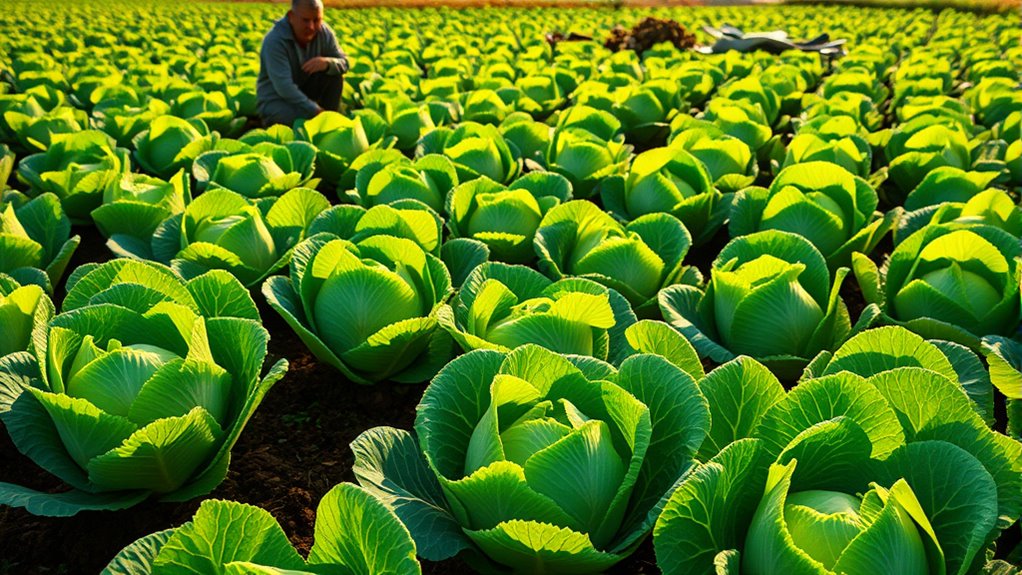
When I think about cabbage cultivation, several key factors come to mind. Choosing the right seed variety, ensuring good soil quality, and providing adequate sunlight and spacing are essential for a successful harvest. Plus, I can’t underestimate the importance of proper watering and fertilization practices to keep my cabbage thriving.
Seed Variety Selection
Choosing the right seed variety is vital for successful cabbage cultivation. I always opt for heirloom varieties like Napa Michihili or Red Acre for their unique flavors and adaptability. These non-GMO options often deliver richer tastes, which my family loves. I also consider the maturity time; for instance, Copenhagen Market matures early in about 70-80 days, allowing me to extend my harvesting season. It’s important to evaluate hardiness zones, as certain varieties thrive in specific climates, like USDA Zones 1-12. Additionally, I pay attention to seed quantity per packet; larger packs, like those with 1000+ seeds, can save money for bigger gardens. Finally, I look for flavor profiles and growth habits that suit my culinary needs.
Soil Quality Requirements
After selecting the right seed variety, it’s important to focus on soil quality for successful cabbage cultivation. I’ve found that cabbage thrives in loamy soil rich in organic matter, which provides essential nutrients for robust growth. Aim for a soil pH between 6.0 and 7.0 to guarantee nutrient availability and reduce disease susceptibility. Good drainage is vital; overly wet soil can lead to root rot, so I always prepare well-draining conditions. While cabbage needs regular moisture, it shouldn’t be waterlogged; I prefer moderate watering to avoid stress on the plants. Finally, confirm the soil is prepared to a depth of at least 6-8 inches. This depth accommodates the root system and promotes healthy growth for a bountiful harvest.
Sunlight and Spacing
Cabbage plants thrive under ample sunlight, so I always aim for at least six hours of direct sunlight each day. This helps them develop properly and stay healthy. Spacing is another critical factor I consider when planting. I space my cabbage plants 12 to 20 inches apart, depending on the variety. This guarantees they have enough room for air circulation and nutrient access. When the seedlings reach about 2-3 inches in height, I thin them out to leave the strongest plants. I also make certain to plant them in well-draining soil, about 1/4 to 1/2 inch deep, for robust root development. Consistent sunlight and correct spacing prevent overcrowding, reducing the risk of disease and stunted growth.
Watering Practices Importance
Watering practices play an important role in successful cabbage cultivation. I’ve learned that these plants thrive with moderate watering, keeping the soil consistently moist to support ideal growth. However, I’ve also seen how overwatering can lead to waterlogged soil, increasing the risk of root rot and other diseases. It’s critical to adjust my watering based on weather conditions; cool temperatures mean less frequent watering, while hot, dry spells call for more. Regularly monitoring soil moisture levels is essential to guarantee my cabbage receives just the right amount of water. As a general guideline, I water my cabbage deeply once or twice a week, depending on soil type and climate, encouraging strong root development and robust head formation.
Fertilization Frequency Guidelines
When it comes to fertilization, I find that applying nutrients every 4-6 weeks during the growing season is key for healthy cabbage development. Using a balanced fertilizer or compost enhances soil fertility, ensuring your plants get the nutrients they need. Before planting, I always amend the soil by incorporating compost to improve its structure and nutrient content. This sets the stage for robust growth. I also recommend regular soil checks to gauge if additional fertilization is necessary, especially if you notice poor growth or yellowing leaves. Finally, mulching with organic materials not only retains moisture but also suppresses weeds, which can reduce the need for frequent fertilization by maintaining overall soil health. Happy gardening!
Pest Control Strategies
Healthy cabbage plants thrive not just on proper fertilization but also on effective pest control strategies. I’ve found that implementing crop rotation works wonders to disrupt the life cycles of pests like aphids and cabbage worms. It’s amazing how this simple technique can reduce those pesky populations over time. Using row covers is another game-changer; they physically block pests while still letting sunlight and moisture in for my young plants. I love introducing beneficial insects, like ladybugs, to create a natural ecosystem. When necessary, I apply organic insecticides like neem oil to target specific pests without harming beneficial ones. Finally, I regularly inspect my plants, promptly removing any affected leaves to keep infestations in check.
Harvest Timing Techniques
How do you know the right time to harvest your cabbage? I’ve learned that the best heads are about 6-8 inches in diameter. It’s essential to cut at the base to protect those outer leaves, which can still grow or be composted. For varieties like the Copenhagen Market Early Cabbage, I usually harvest when the heads feel firm, around 60-75 days after planting. Timing is key; I aim to pick my cabbage before the first frost, as cold can compromise both texture and flavor. Regularly checking for firmness and size helps me nail that perfect harvest window, ensuring I enjoy the freshest, most flavorful cabbage possible. Happy harvesting!
Frequently Asked Questions
What Are the Best Soil Conditions for Growing Cabbage?
When I think about growing cabbage, I know the soil plays a vital role. I’ve found that cabbage thrives in well-drained, loamy soil rich in organic matter. A pH level between 6.0 and 6.8 works best for me. I also make sure to keep the soil consistently moist but not soggy. By focusing on these soil conditions, I’ve seen my cabbage grow healthier and more robust, leading to a fantastic harvest.
How Often Should I Water My Cabbage Plants?
You’d think cabbage plants are like camels, needing little water, right? Actually, they thrive on consistent moisture. I water mine about 1-2 inches a week, adjusting for rain. Too much or too little can spell disaster! I’ve learned that keeping the soil evenly moist helps avoid stress and promotes healthy growth. So, don’t be fooled—give your cabbages the attention they need, and you’ll reap a rewarding harvest!
What Pests Commonly Affect Cabbage Crops?
When it comes to pests affecting cabbage crops, I’ve noticed a few common culprits. Cabbage worms, aphids, and flea beetles often invade my plants. I’ve found that inspecting my crops regularly helps me catch them early. I also use natural deterrents like neem oil, which works wonders. Keeping my garden clean and free of debris has made a big difference too. It’s all about staying vigilant to protect my cabbage!
When Is the Best Time to Harvest Cabbage?
You might think harvesting cabbage is simple, but timing’s essential. I’ve found the best time to harvest is when the heads feel firm and dense, usually about 70 to 120 days after planting. If the outer leaves start turning yellow, it’s a sign to act fast! I like to harvest in the morning; the cool temperatures help preserve freshness. Trust me, picking at the right time makes all the difference in flavor!
Can I Grow Cabbage in Containers or Raised Beds?
Absolutely, you can grow cabbage in containers or raised beds! I’ve had great success using both methods. Just make sure the containers are at least 12 inches deep to give the roots space to grow. When I use raised beds, I find that the soil drains better, which helps prevent rot. Remember to keep them well-watered and provide some shade during the hottest part of the day for ideal growth. Happy gardening!
Conclusion
In the world of cabbage cultivation, choosing the right seeds can feel like standing at a crossroads. On one side, you’ve got vibrant Napa Michihili and robust Red Acre, while on the other, the delicate Savoy and classic Copenhagen Market beckon. Each variety offers its own unique benefits, much like the colorful pieces of a jigsaw puzzle that fit together to create a beautiful harvest. By carefully selecting and nurturing your seeds, you’ll watch your garden flourish with life.
